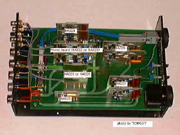
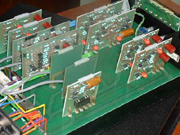
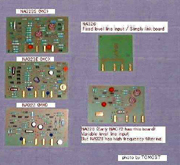
Naim Preamp Mods and Upgrades
page and links generously contributed by Ced Taylor: www.acoustica.org.uk (opens new window)
| For where to find parts, order codes and rough prices of components described here, please check on the components and supplies list pages. As usual here at Acoustica, you hack up perfectly good, working equipment completely at your own risk. Us getting away with it is no guarantee of a repeatable result. Season to taste, some settling of contents may have occurred in transit... |
| Nac 72- Pictures |  |
 |
 |
| Nac 72 inners (fig 1) | Nac 72 inners (fig 2) | Nac 72 boards (fig 3) |
| Gain boards | 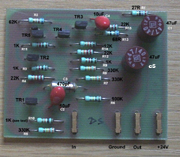 |
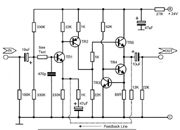 |
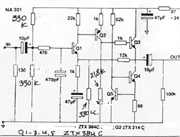 |
| Nac 32.5 gain board (fig 4) | Recent Gain board schematic (fig 5) | Early Gain board schematic (fig 6) |
| Buffer boards | 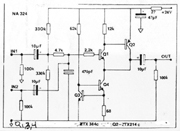 |
|
| Buffer board schematic (fig 7) | ||
| 729 Time aligned boards |  |
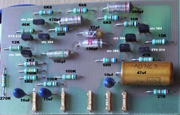 |
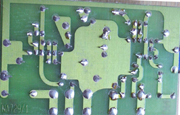 |
| 729 board schematic (fig 8) | time aligned board parts(fig 9) | time aligned board tracks (fig 10) | |
| Preamp Internals | 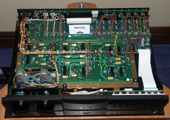 |
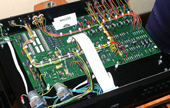 |
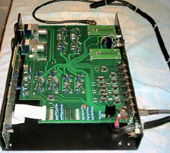 |
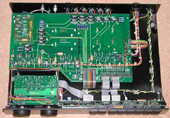 |
| Nac552 (fig 11) | Nac252 (fig 12) | Nac102 (fig 14) | Nac52 (fig 13) |
|
Board descriptions
|
NA323
K/S Phono MC
|
|
Overview
|
Upgrading the preamp really boils down to 3 key areas: 1)
power supplies These are not really clearly seperate issues as there is some crossover between the subjects and also involve external psu's of various designs. However the gains that can be gotten from these areas are all large and can transform a humble little 32.5 into a total giant killer of a preamp that can stomp naims finest products. POWER
SUPPLIES
to a large extent boil down to the quality of the regulator used and monolithic
regs such as the lm317 are NOT up to scratch. See PSU page for more on
thisl
|
|
|
Most of these mods are based on working on a NAC32.5 which is extremely easy to mod because it is made up of boards that can be pulled and is extremely cheap (roughtly half the price of the Nac72 which is its closest cousin. However, from reports these mods seem pretty effective in all the preamps in one form or another though i wouldn't do them on anything more than a NAC72 or Nac102 if you want remote, as beyond that you get more value by selling up, buying the cheaper preamp and using the surplus money to mod. If you intend to mod preamps such as the Nac62 which has a mother board it may be worth doing them all in one go. Each and every one is a tested improvement and the hassle of getting the motherboard in and out again may not be worth it. |
| Mod | Comments and information | approx cost | Bang for buck | ||
| DROP IN MODS | The following mods all involve simple component changes and can be performed without any drilling- the new components just slip into the holes of the old. A few minutes with a soldering iron and a few pounds will give you a stunning whole new preamp and can be unequivocally recommended. They will take a NAC 32.5 to roughly NAC 82 level (IMO) having owned both. I recommend give it a try, you will notice the improvement from cold and full burn in will take a few days. You WILL be happy and may think about going further. | ||||
| 1 | upgrade gain boards | Upgrade old NA321 gain boards to current (Nac82) status |
There
are 4 basic component changes that need to be made to upgrade the gain
boards on all preamps prior to the Nac72 (I believe) to Nac 82 (and probably
all current preamps that use this circuit) status. These are drop in replacements.
|
£2 | 6/10 |
| 2 |
Powerrail decoupling capacitors
|
upgrade with oscon SP series |
Upgrade
to all boards. A Drop in replacement. Note
1: Note you really want oscon SP series not SH or any other type as they
are by far the highest specced 'audio grade' oscons.
|
6 caps @£2.50 each = £15 | 8/10 |
| 3 |
Feedback decoupling capacitor
|
Replace with Elna Silmic |
This
is a must do mod. Only on the gain board. Drop in replacement.
|
2 caps @ £1.50 = £3 | 10/10 |
 |
Replace with Black gate N series |
People have also used these with reported good results though not tried them myself in this position. My personal tastes based on experience of black gates as coupling caps would be 'nah' but you never know- I might be totally wrong. Note the burn in with black gates is also 2 weeks as an absolute minimum (they sound terrible at the start) which is a pain and they revert to their unburned-in state if left unpowered for a while. Personally I don't like what black gates do but some people swear by them. If in doubt a silmic is quintessential Naim.
|
2 caps @ £7.50=£15 | ? | |
| 4 | signal path capacitors | Upgrade these capacitors |
This
is complicated. There are several possibilities here that
can be used to replace the blue 10uf, 35V tantalum input and output caps
on all the boards. |
||
|
a)
10uf, 25V BC128 solid aluminium caps. These are very musical, with more
detail, punchyness and muscial involvement.. Bass is a bit Flabby initially
but burns in within a week or so becoming tight and groovy.They can sound
slightly bright or revealing in the treble. |
£0.70 each | 6/10 | |||
 |
b)
2.2uf Evox Rifa SMR polyphynelsulphide caps. Use only on the INPUTS ONLY
of every board (board output caps do need to be 10uf or bass dissapears).
With them Bass become exceptionally tight and punchy, dynamics increase,
the whole soundstage opens out more and you get greater transparency and
clarity. Things sound more realistic or' in your livingroom'. In my opinion
the best signal path caps. Some have found the sound a little 'grey' which
I acknowledge so again your whole system needs to be up to scratch. |
£2 each | |||
| c)
10uf, 35V elna silmics. Musical, warm and detailed caps. Possibly not quite
the tightest bass but a nice alternative to tantalums and no hint of brightness. |
0.95 each | ||||
|
d) 10uf, 50V black gate N series caps. expensive with very open and seductive sound, but ultimately unmusical caps IMO. Bass and dynamcs leave somewhat to be desired and does not seperate out musical strands well- instruments seem to mush together in the midle of the soundstage in a very un-naimlike manner. Some swear by them but personally find them 'hi-fi' and boring. |
£3.20 each | ||||
|
e)Mix
and match. A good mix is 2.2uf SMRs on the input of all boards, 10uf BC128s
on the output of the buffer boards and 10uf Elna Silmics on the output
of the main gain board.
|
various | ||||
| 5 |
Feedback path Resistor upgrades
|
Upgrade to Welwyn RC55 resistors |
Naim
use the BC componets SFR25 resistors everywhere which can be improved
on. |
£4 | 2/10 |
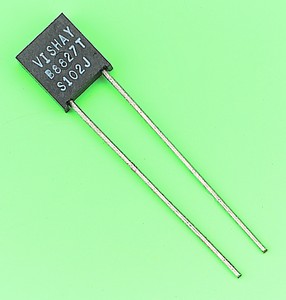 Vishay S102J |
VishayS102J bulk foils |
Not tried them but reports are that they are somewhat soft in sound. Also stupidly expensive. and you can't get the 12K value so would need to parallel 2.
|
£12 | ? | |
| vishay dale cmf55 |
These
are nice alternatives. Smooth, detailed with good bass and my favourite |
0.20 each | 2/10 | ||
| 6 | Transistors |
This is not a mod as far as I'm concerned but BC550/560 are perfectly fine replacements for the ztx214/384 transistors. Can't really hear any difference between em anyway. |
|||
| More fiddley mods | These mods all bring further improvements from the medium to the huge but now you start rebuilding the preamp to a certain extent. It is possible to cram the parts in though you may need to look at rebuilding- see below | ||||
| 6 |
On
board regulators |
regulating the preamp variously |
A huge upgrade. Fundamental improvement to the sound. There are various regulators and regulator systems you can use use but the ALW (Jung) superregulators beat any monolithic regulator eg lm317, lt1086 etc. I've heard by an absolute mile. Just bags more detail, dynamics, rythmically tighter, more pitch perfect, faster, textured, more open soundstage, more involving, the works. Truly fabulous. 1/2 regs: the easiest option is to replace the lm317 regulators with superregs in your psu. See the psu page for information on this or http://www.alw.audio.dsl.pipex.com/ does a very indepth write up on modding a snaps and the oscap hicap clone. 1/2 regs: Another option, if you don't have a psu, is to place them directly in the preamp and use the powerline from the poweramp for voltage feed. This means delving into your poweramp which has an internal lm317t regulator and changing the resistor to give a minimum of 30V going to the pre (an ALW regulator needs 5V headroom. However a bonus is that regulators ideally work best closest to the circuit they are regulating. For calculating these resistor values see the lm317t datasheet which you can pull off the internet. Finding space for 2 superregs in a NAC 32.5 or similar case is no problem at all. 6
regs:
Using 6 onboard superregs is also possible so you can regulate each board
(4 buffers and 2 gain boards) independently which is an optimum solution.
This is easiest with a wide case amp e.g the Nac102. However you get a
fair proportion of the gains just using two regs. Be warned that there
have been a couple of reports of increased hiss if using the superregs
onboard. Never had ANY problem with this personally in all the various
iterations I've tried though. For
more information on superregs and how to build them see the psu page or
go to ALWaudio website at
http://www.alw.audio.dsl.pipex.com/ and download the manual. For
details on superregs, see the PSU page.
|
~£30 each | 10/10 |
| 7 |
feedback capacitor
|
replace with polyester cap |
As
the feedback cap is the most sensitive part of the preamp, upgrading this
cap from an elna silmic to a film cap should reap greater rewards....
and it does. Replacing C5 on the gain boards with a 47uf, 63v evox rifa
MMK polyester cap brings further gains. From cold these caps are a whisker
better than fully warmed up silmics and over a couple of days they burn
in subltly to provide what can only be desribed as a bit of magic. Its
subtle but it strips away distortion so everything becomes more relaxed
but at the same time more intense, less harsh, more musical. It is hard
to describe but it allows you deeper access to the music with more emotion,
intensity and less effort. You'll have to cram this in but use extension
leads to the cap and afix the cap conviently as close as possible to the
circuit. Use hotmelt glue or something to hold the cap in place.
|
£15 | 9/10 |
| 8 |
power rail decoupling capacitor
|
replace with film caps |
This
is brilliant but apparently only works if you are using supperregulators.
normal LM317 type regs won't work.
|
£2 each | 9/10 |
| 9 | Coupling caps | replace all signal path caps with smr caps |
Replace the OUTPUT coupling caps with 10uf Evox SMRs. They're big so you really need to either hot glue them to the mother board and run flying leads to the pcb holes or do somehting of this nature. lenth of flying leads is not an issue. An upgrades motherboard is another possibility. They increase the effect of input SMR caps with yet more transparency and tighter bass but see the caveats in mod 4 above regarding their sound balance.
|
£7 each | 5/10 |
| 10 | removing the balance pot |
remove
the balance pot and replace with 2 welwyn rc 55y or any good quality resistors
e.g vishay dale cmf55s. Try values around 2k67. Not tried this yet but
apparently cleans up the sound a bit. |
£2 | ? | |
| 11 | Upgrading the volume pot |
Replace the volume potentiometer with a nobel or panasonic pot. Panasonic pots are apparently very detailed. Nobel slightly smoother. Possibly the best may be a stepped attenuator stuffed with vishay dale cmf55 resistors. These are sold for a rediculously low prices on ebay from malaysia (you have to search) but seem to get universal good reveiws. apparently they need to burn in significantly and being a stepped type this is difficult so you need to connect all the resistors up and burn them in before installing is the advice. Not tried these myself yet. see recommended components page for info.
|
£30-£60 | ? | |
| Rebuilds 1- The Motherboard | This involves rebuilding your preamp with a motherboard but brings further gains and allows the higher level mods to be incorporated into a narrow shoebos preamp case. | ||||
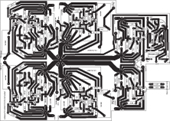 |
overlay |
This motherboard is based on the NAC82 layout though oddly enough the Nac252 has a similar board. However it has been redesigned to allow space for large film caps for ultimate performance. Also being very compact it allows for placing 6 superregs in a shoebox sized case though there is probably insufficient space for phono cards so its a line stage only solution. Additionally it has the time aligned filter section on not just the buffer boards of earlier models. The grounding scheme is important to sound quality and using this tighter grounding layout and also star supplying the powerrails reaps considerable benefits compared to a nac32.5s when using identical parts. The effects are similar to going from standard caps to elna silmics in the feedback loop. More ease of access to the music, more texture more easy to listen too and adds some magic. for this project you need to download the pcb schematic and etch onto a pcb, stuff using the parts list given then rewire the preamp cutting out the mother board. If you don't feel comfortable doing this or can't figure out how to you probably shouldn't attempt this project. For
details on superregs, see the PSU page.
|
|||
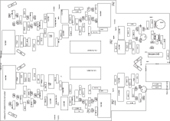 |
stuffing guide |
These
datasheets should come in useful but basically you need to turn around
the bc parts 180o to the zetex parts as the pinouts are different However as I feel this idea has been superseeded by the 'Air Guitar-iste' preamp project below I've not put together a parts list. The bits are all available by cannabalising from the 'Air Guitar-iste' bits, the recommended components web page and a bit of serching on farnell.
|
|||
|
|
pcb |
See the Air Guitar-iste preamp build notes below for how to etch your own pcb |
|||
| Rebuilds 2- The 'Air Guitar-iste' preamp | This is a stripped down and optimised version of the motherboard. Less functionality (a pure line stage only) but higher performance AND happily cheaper but it is the core naim circuit and has been rebuilt of the naim principles of optimising powersupplies and grounding though with top notch (I think) parts. | ||||
|
The Air Guitar-iste preamp (gotta call the thing something) is' rather nice' or the best preamp soundwise I have been able to build in 6 years of fooling around and modding the naim pres and scrounging ideas from everywhere possible, primairily pink fish, avondale, diyaudio.com. It incorporates the very finest of all the psu, grounding and component upgrades I've managed to find and test and is actually extremely simple to build. In fact you can build it from scratch or hack a normal preamp and build it. Parts and timewise it is far simpler to build than the mother board. And nope, theres no 729 style time aligned filter boards and yep, read the build notes for an explanation of why not. For an idea of whats involved and how it sounds read the build notes below. I would however confidently expect it to stomp a Nac52 like a bug and for a 'from scratch' build price of around £400 inc psu I reckon thats pretty good. Again
I'd recomend you know a bit about preamps and modding as no backup can
be given and although I'm pretty sure I haven't made any mistakes in my
write up notes and labelling, it will help to know how to check schematics
and know your parts if I have.
|
|||||
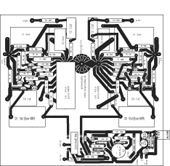 stuffing overlay |
Parts list and datasheets |
Get
the parts list here (microsoft excel document) with rough costings,
order numbers etc. However
here are some datasheets for bits you might want to know more about:
|
|||
|
|
build notes |
Get the build notes here (microsoft word document) with details and pictures for hacking a naim pre or building from scratch. This gives you most of the info you'll need.
|
|||
|
|
PCB |
get pcb artwork here (pdf) get stuffing overlay here (pdf) See build notes above for all details on how to etch your own pcb |
|||
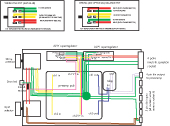 |
Wiring schematic |
get wiring schematic here (pdf) This
is enough to give you the idea. obviously each input socket has to be
wired to the selector which is not shown to make it easier to see. |
|||
 |
Block diagram |
get block diagram here (pdf) just an overview of how a naim preamp runs. for the Air Guitar-iste the 729 buffer has been omited as explained in the build notes and the 32 and upward preamps also have a tape output buffer which is the same as fig7 above as far as I know (not the 729 boards buffer). |
|||